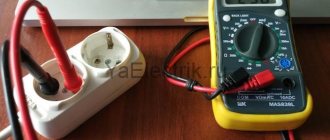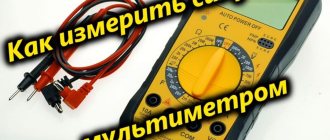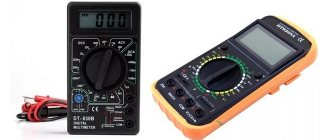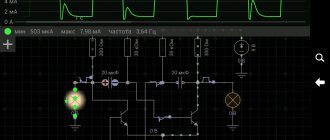Voltage measuring instruments
As a result of direct and indirect measurements, specific data of a physical quantity become known.
Direct ones display the result directly on the scale. The determination of indirect ones is made by calculating the required parameters. The latter method is much more accurate. Measurements are carried out in electrical and radio circuits.
Voltage is measured by equipment
Voltage is measured from one point to another and is characterized by the force transferred from the end of the circuit A to B. The value is displayed using the letter V. The unit of voltage is Volts. To make it easier, the indicator is divided into kilo-, milli- and micro-units. The meter can be electromechanical, electronic, digital or electronic.
Voltmeters
It is this device that is taught when measuring voltage in physics lessons. The action of the meter is based on Ohm's law. The measurement is made using an electromagnetic field. The characteristics of the device are improved with high internal resistance and a wide range of values. Devices that determine kilo-, milli- and micro-units are conventionally called kilovoltmeters, millivoltmeters and microvoltmeters. The last two ranges have minimal error.
It is necessary to know the circuit voltage
There are 2 types of voltmeters.
Electronic is a highly sensitive device with high resistance. Allows you to define wide ranges of values. It is distinguished by the addition of a converter to the main mechanism. Such devices require current as a power source. Analog and digital voltmeters are known. The first operate by converting the input alternating voltage to constant, gradually deflecting the arrow. The IP also includes a scale. When the current flows in the opposite direction, the arrow moves to the left; when the current flows normally, it moves to the right. So whether the voltage is positive or negative should be considered. Digital voltmeters immediately read the voltage at the input and display the data on the display. Accuracy depends on the quality of the analog-to-digital converter, but digital voltmeters still have less error than analog ones.
Electronic models are widespread
Electromechanical ones differ in that they do not need a current source to operate. After connecting a voltmeter to the circuit, the device determines the input value, which is reduced using a special internal or external resistor. Internal resistors are connected in series from the inside of the case, external ones - from the outside. The device is compact and inexpensive, but can consume power from the circuit. The measurement range is not very wide, so an accurate result cannot always be obtained.
When choosing a device, the measurement category matters. Voltmeters for direct and alternating current, selective, pulse, phase-sensitive and universal instruments are provided.
- Pulse. Helps cope with network outages. Checks the voltage of a single pulse signal. Thanks to this, you can find out where the interference appears in the circuit and eliminate it.
- Phase sensitive. The value is derived by converting a constant or minimally varying voltage. The scoreboard displays the overall result.
- Selective. The device is narrow-band, selectively gives an idea of the amplitude and frequency of one of the parts without turning off the other. The device is needed if you need to isolate some components of a large area.
- Universal. It combines all types of voltmeters, allowing you to determine the electromotive force in different areas and under any conditions.
- Voltmeters for direct and alternating current determine the corresponding values.
A universal device is more convenient.
Portable, stationary and panel devices can be, depending on the possibility of movement, size and design features.
- Shield ones. Designed to be placed in special cabinets. After purchase, they are installed and located at the installation site. It can be transferred, but rarely and carefully.
- Stationary. Due to their bulkiness, it will be difficult to move them. The inconvenience of use is offset by high technical characteristics, accuracy and a large measurement scale.
- Portable. They do not require connection to an energy source and can be moved freely. Compact, housed in a neat case.
There are stationary models
Potentiometer
A potentiometer can be called a current regulator device. It is a 3-pin, open variable resistor. In most cases it has a tap contact. It is especially widespread when working with audio systems and in the automotive industry.
During operation, one of the terminals is connected to a contact, the other two are tap-offs. The base is made of carbon and ceramic materials.
The essence of the phenomenon
Voltage is the electrical driving force that is designed to push free types of electrons from one atom to another in a certain direction. A mandatory requirement for the flow of charges is the presence of a circuit with a closed loop, which creates the conditions for them to move. If there is a break in the electrical circuit, then the process of directional movement of particles stops.
Note! It is worth noting that the unit of voltage in an electrical circuit depends on the material of the conductor, how the load is connected, and what the temperature is.
How to use it correctly
- Collect information about a technical problem.
- Check that the subject being measured is not damaged.
- Connect the probes to the sockets.
- Turn on the device and select the desired mode. They specify whether DC or AC voltage will be measured.
- The measurement is carried out parallel to the network.
- Read the result on a scale or scoreboard.
Connection is carried out in parallel
Safety regulations
- Grounding is required.
- The device and chain cannot be touched with bare hands.
- If unforeseen situations occur, stop work immediately and make sure that the measurement does not have consequences. For example, a fire will not be created.
- The device is connected in parallel to an already assembled circuit.
- The workplace must be isolated from strangers.
- The person measuring must have an understanding of safety precautions, know the design of the device and the principle of its operation.
- The chain must be assembled correctly.
- At the end of the work, the device is turned off and disassembled, placed in the storage location in appropriate cases. The worker removes protective equipment and thoroughly cleans his hands.
How to measure voltage?
Dim light from lighting fixtures or the refusal of the washing machine to perform its functional duties indicates a possible drop in the supply voltage below normal. In such cases, it is necessary to measure the voltage, which will determine its compliance with the specified rating of the electrical network.
The same procedure is performed when repairing electronic devices, where the voltage drop on radio components and individual sections of the circuit is measured. This procedure is performed quite easily, but without understanding the physics of the process and the specifics of taking measurements, a person risks not only damaging expensive equipment, but also getting electrical injury, so next we will look at the basic principles of measurement.
Designations [edit | edit code]
In foreign countries, the designations of measuring instruments are established by manufacturers; in Russia (and partly in other CIS countries) a unified designation system has traditionally been adopted, based on the principles of operation of electrical measuring instruments. The designation includes a capital Russian letter corresponding to the principle of operation of the device, and a number - the conventional model number. For example: C197 - electrostatic kilovoltmeter. The letters M (modernized), K (contact) and others may be added to the designation, indicating design features or modifications of devices.
- vibration type devices (reed)
- electrodynamic devices
- measuring transducers
- induction devices
- multi-channel and complex measuring installations and systems
- logometers
- magnetoelectric devices
- recording devices
- auxiliary measuring devices
- measures, measuring transducers, instruments for measuring parameters of electrical circuit elements
- electrostatic devices
- thermoelectric devices
- measuring installations
- electronic devices
- normal elements
- rectifier type devices
- measuring transducers
— panel devices
- electromagnetic devices
03 Nov 2016 | Section: Electrics
Hello, dear readers of the site sesaga.ru. The basic unit of measurement for electrical voltage is the volt. Depending on the magnitude, voltage can be measured in volts
(V),
kilovolts
(1 kV = 1000 V),
millivolts
(1 mV = 0.001 V),
microvolts
(1 μV = 0.001 mV = 0.000001 V). In practice, most often you have to deal with volts and millivolts.
There are two main types of voltages - constant
and
variable
. Batteries and accumulators serve as a source of constant voltage. The source of alternating voltage can be, for example, the voltage in the electrical network of an apartment or house.
A voltmeter is used to measure voltage . pointer voltmeters
(analog) and
digital
.
Today, pointer voltmeters are inferior to digital ones, since the latter are more convenient to use. If, when measuring with a pointer voltmeter, the voltage readings have to be calculated on a scale, then with a digital one, the measurement result is immediately displayed on the indicator. And in terms of dimensions, a pointer instrument is inferior to a digital one.
But this does not mean that pointer instruments are not used at all. There are some processes that cannot be seen with a digital instrument, so switches are more used in industrial enterprises, laboratories, repair shops, etc.
On electrical circuit diagrams, a voltmeter is indicated by a circle with a capital Latin letter “ V”
" inside.
Next to the symbol of the voltmeter, its letter designation “ PU
” and the serial number in the circuit are indicated.
For example. If there are two voltmeters in the circuit, then write “ PU 1
” near the first one, and “
PU 2
” near the second one.
When measuring direct voltage, the diagram indicates the polarity of the voltmeter connection, but if alternating voltage is measured, the polarity of the connection is not indicated.
Voltage is measured between two points
circuits: in electronic circuits between
positive
and
negative
poles, in electrical circuits between
phase
and
zero
.
The voltmeter is connected in parallel to the voltage source
or
in parallel to a section of the circuit
- a resistor, lamp or other load on which the voltage needs to be measured:
Let's consider connecting a voltmeter: in the upper diagram, the voltage is measured on the HL1
and simultaneously on the power supply
GB1
.
In the lower diagram, the voltage is measured across lamp HL1
and resistor
R1
.
Before measuring the voltage, determine its type
and approximate
value
. The fact is that the measuring part of voltmeters is designed for only one type of voltage, and this results in different measurement results. A voltmeter for measuring direct voltage does not see alternating voltage, but a voltmeter for alternating voltage, on the contrary, can measure direct voltage, but its readings will not be accurate.
It is also necessary to know the approximate value of the measured voltage, since voltmeters operate in a strictly defined voltage range, and if you make a mistake with the choice of range or value, the device can be damaged. For example. The measurement range of a voltmeter is 0...100 Volts, which means that voltage can only be measured within these limits, since if a voltage is measured above 100 Volts, the device will fail.
In addition to devices that measure only one parameter (voltage, current, resistance, capacitance, frequency), there are multifunctional ones that measure all these parameters in one device. This device is called a tester
(mostly dial gauges) or
digital multimeter .
We won’t dwell on the tester, that’s the topic of another article, but let’s move straight to the digital multimeter. For the most part, multimeters can measure two types of voltage within the range of 0...1000 Volts. For ease of measurement, both voltages are divided into two sectors, and within the sectors into subranges: DC voltage has five subranges, AC voltage has two.
Devices used
In every home, the electricity meter is in a state of constant measurement of alternating voltage, but it is extremely rare that this data is displayed anywhere. Some of them are connected directly, others through instrument transformers.
For practical purposes, the following can be used to measure voltage levels:
A voltmeter is a device for testing potential differences. In practice, you can find both digital and analog voltmeters, in which the measured voltage is displayed on the display or by deflecting the arrow on the dial, respectively.
Important parameters when choosing both an electronic and a pointer voltmeter are units of measurement (mV, V, kV), operating range and accuracy class. However, the scope of their application is limited and is used, most often, for laboratory research, since for domestic and industrial needs it is impractical to maintain one device for measuring one electrical quantity.
A multimeter or digital tester is a more versatile device that can work with several parameters: electric current, resistance, frequency, temperature, voltage, etc. To measure voltage, the multimeter switches to voltmeter mode, the probes are connected to the appropriate connectors. Structurally, there are both digital and analogue models, in some of them you can switch the measurement range, select the type of current, in other multimeters all these values can be selected automatically.
An oscilloscope is a rather complex instrument for measuring potential differences, since it displays a curve of the measured value on a digital or analog display. In this case, you can stretch or shorten the frequency range to consider the shape of the pulse voltages, pulse duration, rises and dips in the function curve. Therefore, an oscilloscope for measuring voltage is used in electrical circuits and high-precision devices, in the manufacture and testing of radio components, etc. Few people keep an oscilloscope at home due to the high cost and complexity of operations.
Classification [edit]
- The most essential feature for the classification of electrical measuring equipment is the physical quantity being measured or reproduced; according to this, devices are divided into a number of types:
- ammeters
- to measure the strength of electric current; - voltmeters
- for measuring electrical voltage; - ohmmeters
- for measuring electrical resistance; - multimeters
(otherwise testers, avometers) - combined instruments - frequency meters
- for measuring the frequency of oscillations of electric current; - resistance stores
- for reproducing specified resistances; - wattmeters and varmeters
- for measuring the power of electric current; - electric meters
- for measuring consumed electricity - and many other types
- In addition, there are classifications based on other criteria:
- by purpose - measuring instruments, measures, measuring transducers, measuring installations and systems, auxiliary devices;
- by the method of presenting measurement results - showing and recording (in the form of a graph on paper or film, printout, or in electronic form);
- by measurement method - direct assessment devices and comparison devices;
- by method of application and design - panel-mounted (attached to a panel or panel), portable and stationary;
- according to the operating principle:
Network voltage measurement
In order to correctly measure voltage, it is necessary to clearly understand the principle and object of study. Therefore, it should be noted that voltage is an electrical quantity that shows the difference in charge between two electrical points. For example, if at one point the charge is +35 V, and at another +310 V, then the difference between these points will be 310 - 35 = 275 V, this will be the voltage. Accordingly, voltage measurements can only be made relative to something, so two points are used at once.
If we talk about the voltage drop at any object or section of the circuit, then the voltage measurement is carried out relative to the ends of the device or circuit, connection points, etc. It is important to take into account that a digital voltmeter or multimeter in measurement mode is considered to have infinite resistance or an open circuit.
A voltage drop is possible only if current flows, so connecting voltmeters in series with the object being measured is unacceptable, since current will stop flowing through it. An analogue or electronic voltmeter must only be connected in parallel with the signal being measured.
Classification [edit]
- The most essential feature for the classification of electrical measuring equipment is the physical quantity being measured or reproduced; according to this, devices are divided into a number of types:
- ammeters
- to measure the strength of electric current; - voltmeters
- for measuring electrical voltage; - ohmmeters
- for measuring electrical resistance; - multimeters
(otherwise testers, avometers) - combined instruments - frequency meters
- for measuring the frequency of oscillations of electric current; - resistance stores
- for reproducing specified resistances; - wattmeters and varmeters
- for measuring the power of electric current; - electric meters
- for measuring consumed electricity - and many other types
- In addition, there are classifications based on other criteria:
- by purpose - measuring instruments, measures, measuring transducers, measuring installations and systems, auxiliary devices;
- by the method of presenting measurement results - showing and recording (in the form of a graph on paper or film, printout, or in electronic form);
- by measurement method - direct assessment devices and comparison devices;
- by method of application and design - panel-mounted (attached to a panel or panel), portable and stationary;
- according to the operating principle:











